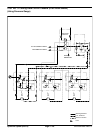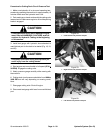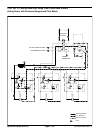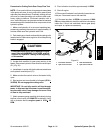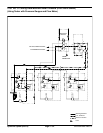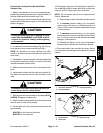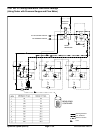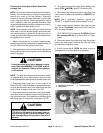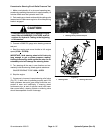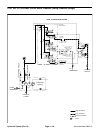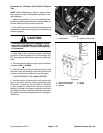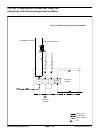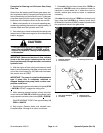
Rev. F
Groundsmaster 4000--D Hydraulic System (Rev. B)Page 4 -- 35
Procedure for Cutting Deck Motor Case Drain
Leakage Test
NOTE: Overa period of time, adeck motor can wear in-
ternally. A worn motor may by--pass oil to its case drain
causing the motor to be less efficient. Eventually,
enough oil loss will cause the deck motor to stall under
heavy cutting conditions. Continued operation with a
worn, inefficient motor can generate excessive heat,
cause damage toseals and other components in thehy-
draulic system, and affect quality of cut.
NOTE: One method to find a failing or malfunctioning
deck motor is to have another person observe the ma-
chine while mowing in dense turf. A bad motor will run
slower, produce fewer clippings, and maycause adiffer-
ent appearance on the turf.
1. Make sure hydraulic oil is at normal operating tem-
perature by operating the machine for approximately 10
minutes. Make sure the hydraulic tank is full.
2. Parkmachine on alevel surface withthe cuttingunits
lowered and off. Make sure engine is off and the parking
brake is engaged.
CAUTION
Prevent personal injury and/or damage to equip-
ment. Read all WARNINGS, CAUTIONS, and Pre-
cautions for Hydraulic Testing at the beginning
of this section.
NOTE: The side deck motors are connected in series.
To isolate a faulty motor, both motors in the circuit may
havetobetestedbystartingwiththeleftsidemotorfirst.
3. Disconnect hose from return of the motor to be
tested (Fig. 24). Install flow tester in series with the mo-
tor and disconnected return hose. Make sure the flow
control valve on tester is fully open. (Fig. 25).
4. Disconnect the motor case drain hose (small diame-
ter hose)where it connects tohydraulic manifold tee--fit-
ting (notat the motor). Puta steel cap on the fitting at the
tee--fitting; leave the case drain hose open (Fig. 25).
CAUTION
Cutting unit blades will rotate when lowered with
PTO switch in ON position. Keep away from cut-
ting units during test to prevent personal injury
from rotating blades. Do not stand in front of the
machine.
5. Sit on seat and start the engine. Move throttle to full
speed (2730 +
30 RPM). Move PTO switch to ON.
6. While watching pressure gauge, slowly close flow
control valve ontester until apressure of 1200PSI isob-
tained.
NOTE: Use a graduated container, special tool
TOR4077, to measure case drain leakage (Fig. 25).
7. Have another person measure flow from the case
drain line for 15 seconds, then move the PTO switch to
OFF and stop the engine.
TEST RESULTS: Flow less than 0.7 GPM (less than
22.4 ounces (662 ml) of hydraulic fluid in 15 sec-
onds).
8. Disconnect tester from motor and hose. Reconnect
hose to the deck motor. Remove cap from tee--fitting
and reconnect case drain hose.
9. If flow is more than 0.7 G PM, the motor is worn or
damaged and should be repaired or replaced.
1. Deck motor (RH shown)
2. Return hose
3. Case drain hose
Figure 24
1
3
2
Figure 25
Hydraulic
System




